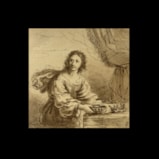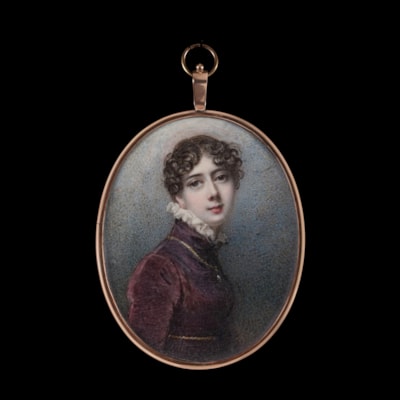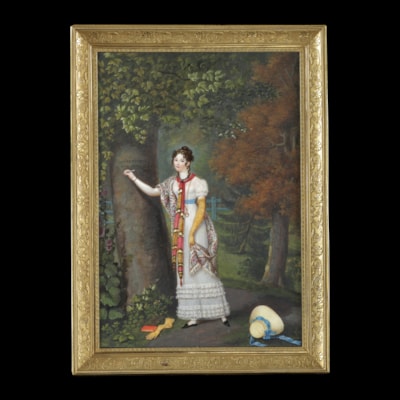EMMA ELEANORA KENDRICK
(c.1788-1871)after Guercino
(1591-1666)Sophonisba with the bowl of poison
Ink and wash on paper
87mm x 85mm
SOLD
In 1830, Kenrick published Conversations on the Art of Miniature Painting, a volume recording the art of miniature painting through a dialogue with the artist and an imaginary lady ‘Ellen’. Beyond limning however, Kendrick was an accomplished watercolourist and produced numerous paintings of classical, mythological and literary subjects.
The subject of this drawing - Sophonisba, or Saphanba'al, daughter of Hasdrubal - married Syphax whom she thus won over to the Carthaginian cause. When Masinissa and Laelius overthrew Syphax in 203 B.C., Sophonisba took poison sent to her by Masinissa, now enamoured of her and unable by any other means to save her from captivity at Rome. Her new husband encouraged her to die with dignity rather than become a captive. She chose suicide by poison.
The present work show’s Kendrick’s intimate knowledge of the Royal Collection as the image is copied from a sepia drawing attributed to Guercino, which entered the Royal Collection during the reign of George III [RCIN 902420]. The collection also houses the copy of the drawing etched by Bartolozzi, and Kendrick may have used this as her source. The Bartolozzi etching of the same subject was also copied by Lady Elizabeth Spencer (1764-1812), daughter of the 4th Duke of Marlborough [still in the Royal Collection RCIN 913564].
It is likely that this study was undertaken in the early part of Kendrick’s career, when she was still making copies after Old Masters in the same vein as Spencer’s copy – as a suitable way to learn but without having to study a real person or tout for commissions – in other words, a genteel form of art for women. Unlike Spencer’s Georgian beautification of Sophonisba, Kendrick remains true to Guercino’s character of the subject, whose face shows the resignation of her fate.
Private Collection, UK.

shipping notice
Worldwide shipping is included in all prices.
The Limner Company does not accept any responsibility for import duty, this is to be paid by the buyer.
Some stock items contain materials from endangered species which are governed by CITES regulations and will require a permit to export outside of Great Britain. If a certificate of export is required then this will be the responsibility of and paid for by the buyer .
you may also like













